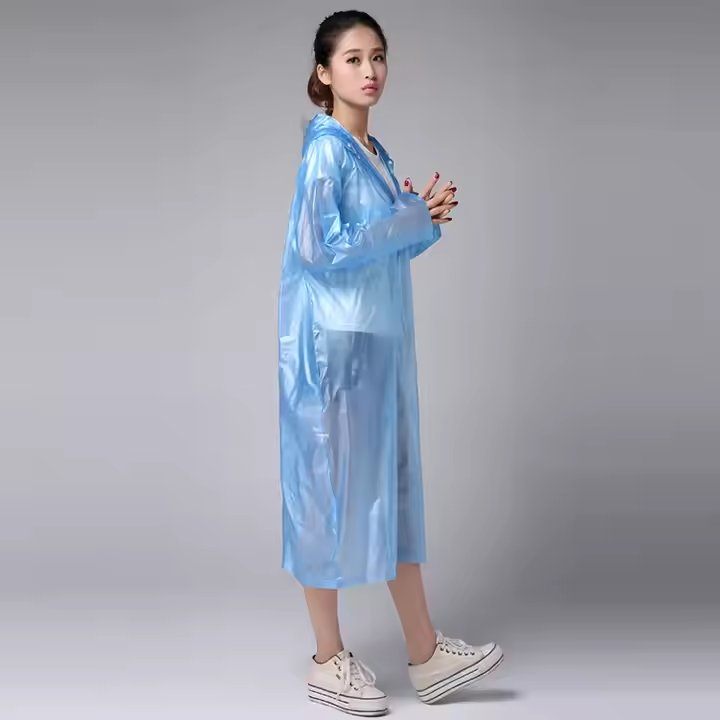Plastic raincoats provide essential protection against rain. They are popular for their durability, affordability, and waterproof capabilities. As demand for rain gear continues to grow, plastic raincoat manufacturers in China offer a wide range of options. These manufacturers produce various types of plastic raincoats, each with unique features tailored to different needs. Below, we explore the types of plastic raincoats available, highlighting their materials, benefits, and drawbacks.
PVC Plastic Raincoat

The PVC plastic raincoat is one of the most common types available in the market. PVC is a highly durable and waterproof material. It offers excellent protection against rain. Plastic raincoat manufacturers in China widely produce PVC raincoats, making them affordable and easily accessible.
Pros:
PVC raincoats are known for their strong water resistance and durability. They are perfect for heavy rain conditions. The material is also cost-effective, which makes PVC raincoats a popular choice among consumers.
Cons:
On the downside, PVC raincoats can be quite heavy and less breathable. This lack of breathability may cause discomfort, especially in warm weather. Despite these cons, they remain a top choice due to their reliable waterproofing features.
PE Plastic Raincoat

Polyethylene raincoats are lightweight and often used for disposable rain gear. These disposable plastic raincoats are highly affordable and easy to carry. Plastic raincoat manufacturers and suppliers in China produce many of these rain ponchos, especially for use in public events or emergencies.
Pros:
PE raincoats are compact, lightweight, and inexpensive. They are ideal for short-term use. Their convenience makes them a go-to option for people on the go or for those who need quick protection from the rain.
Cons:
However, polyethylene raincoats are not as durable as PVC or other materials. They tend to wear out quickly, especially during prolonged exposure to rain. These raincoats are better suited for temporary use and might not be as effective in heavy rain.
EVA Plastic Raincoat

EVA raincoats are softer and more flexible compared to PVC. They are lightweight and offer a comfortable fit. Many manufacturers now offer plastic raincoats with hoods made from EVA for added protection.
Pros:
EVA is more breathable than PVC, making it a more comfortable option in warm weather. It is also less toxic than PVC and biodegradable, which makes it more environmentally friendly. EVA raincoats offer a good balance between comfort and water resistance.
Cons:
The main drawback is that EVA raincoats can wear out faster than PVC options. They are also slightly more expensive, which might make them less attractive to budget-conscious buyers.
PU Plastic Raincoat

Polyurethane raincoats are made from a flexible, breathable material. They are often used in higher-end rain gear, offering a balance of comfort and waterproofing. Plastic raincoat manufacturers in China produce plastic waterproof raincoats using polyurethane to offer enhanced features.
Pros:
PU raincoats are lightweight and breathable, making them more comfortable to wear for longer periods. They provide a good amount of waterproofing and comfort, which is perfect for those looking for a raincoat that can withstand both light and moderate rain.
Cons:
The main downside of PU raincoats is their higher cost compared to PVC or PE options. While they offer more comfort, they might not be as durable as PVC in very heavy rain.
TPU Raincoats

TPU is a more advanced plastic material that combines flexibility and durability. It is highly water-resistant and is often used for high-performance rain gear. Plastic raincoat manufacturers and suppliers in China are increasingly producing plastic transparent raincoats made from TPU for a sleek, modern look.
Pros:
TPU raincoats are flexible, durable, and lightweight. They are highly water-resistant and provide excellent protection in both light and heavy rain. TPU is also more environmentally friendly compared to PVC, making it a great choice for eco-conscious consumers.
Cons:
The main downside of TPU raincoats is their higher price point. These raincoats are typically more expensive than other plastic options, which may deter some buyers.
Nylon with PVC or PU Coating Raincoats

Some raincoats are made from synthetic fabrics like nylon, which are then coated with PVC or PU for waterproofing. These plastic cover raincoats offer a unique combination of fabric and plastic for improved breathability and comfort.
Pros:
Nylon raincoats with plastic coatings are more breathable than pure plastic raincoats. They are often used in stylish rain gear, making them a popular choice for both fashion and function. These raincoats offer a good balance of flexibility and waterproofing.
Cons:
While they are more breathable, these raincoats are less durable than pure plastic options. They might not be the best choice for extremely wet conditions or long-term use.
Conclusion
Plastic raincoats are versatile, functional, and affordable. Plastic raincoat manufacturers in China offer a broad selection of options to suit different needs. Whether you’re looking for a disposable plastic raincoat, a heavy-duty plastic raincoat, or a clear raincoat, there is a solution for everyone. By understanding the features and benefits of each type, consumers can make an informed decision based on their requirements.


